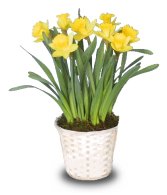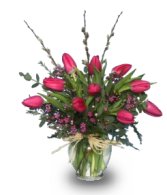Spring is coming early this year, and with it comes the season for blooming bulb flowers like daffodils, hyacinths and tulips… not to mention Easter lilies. There may be no better harbinger of spring than the sight of energetic, new daffodil leaves pushing their way up out of the warming soil, followed closely by young, green hyacinth sprouts. Fortunately, your local florist can help you get a head start on the season by providing a selection of fresh cut bulb flowers that are already available to bring some spring color indoors to your living space.
 Potted Daffodils |
Springtime Daffodils
The cheery sunshine-yellow color of daffodils is practically irresistible. In some parts of the country, daffodils are known colloquially as “Easter flowers”, given that they usually appear during that time each year. In addition to the yellow ‘Dutch Master’ daffodils that are commonly sold as cut flowers, there are a few other varieties that are sometimes available. For example, ‘Fortune’ is a slightly smaller type of daffodil that has a bright orange corona (the “trumpet” part at the center of the flower) set in front of a collar of lemon-yellow petals. ‘Ice Follies’ is a robust variety with a large, egg yolk colored corona backed by ivory petals. There are even ‘double’ types of daffodils that have ruffled centers in place of the usual corona. With some advance notice, your neighborhood flower shop can order some of these specialty types of daffodils for you.
One important thing to remember when handling fresh cut daffodils is that they exude a clear, sticky sap that is harmful to other flowers. Be sure to allow the sap to drain from the cut daffodil stems in a separate vase of water for few hours before combining them with other cut blossoms.
Daffodils are also available as potted plants, grown from bulbs that have been pre-chilled and forced into early bloom. In addition to the above-mentioned daffodil varieties, there is a charming diminutive type called ‘Tete-a-Tete’, a perky little daffodil which grows to 6″ high or less and typically produces more than one bloom scape per bulb.
Hyacinths In Bloom
 Potted Hyacinth |
For spring fragrance, you can hardly beat the popular hyacinths. Hyacinths are usually long lasting as cut flowers and their scent is intensely sweet. It’s best to purchase hyacinths when the florets are not yet fully open. They’ll continue to develop in the vase even after they’ve been cut. In recent years, the range of colors available in hyacinths has grown quite a bit. Besides the familiar purple, pink, and white, hyacinths have been developed to include peach, burgundy, powder blue, and lilac varieties, among other hues. Occasionally, cut hyacinths are available “on the bulb”… in other words, with the upper half of the bulb still attached to the bottom of the stem. Hyacinths like this are generally imported from Holland, and are shipped in a rather immature state. The remaining portion of the bulb provides the extra energy needed for the hyacinth flowers to continue to grow and open. And, the hyacinth bulb itself can be an interesting design element in a floral arrangement.
Hyacinths, too, are available in a miniature form known as grape hyacinths. These sport clusters of tiny, rounded flowers on slender stems that are usually 6″ long or less. Grape hyacinths (Muscari species) are available in blue, white, or purple, and they have a delicate, almost fruity fragrance. They are sold as cut flowers as well as potted plants in many areas.
Freesia Fragrance
Another strongly-scented cut flower is the freesia. Freesias have a unique spicy-sweet fragrance all their own, as well as an individualistic form. Freesia florets are borne on a structure known botanically as a “comb”, referring to the upper portion of the stem which is bent at a right angle and supports 5 to 12 or more flower buds. Freesias open from the back end of the comb first, and the back florets gradually fade as the newer ones open. A trick to induce several florets to remain open at the same time is to pinch off the terminal 2 or 3 buds, which induces the freesia to open more buds at once. Freesias come in a range of hues from deep gold to purple and everything in between, including reds, lavenders, orange, cerise, pale yellow, cream and white. Double-flowered forms are available as well. Freesias are not often sold as potted plants. Their stems are so slender and wiry that they tend to tangle or fall over unless grown in maximum light.
Tulip Time
Finally, tulips … among the most beloved of all flowers. Tulips are now available to florists year round, due to advanced forcing techniques. However, the range of colors, shapes, and sizes is most abundant in the early spring. Pinks, yellows, reds and whites abound, including striped and bi-color varieties. Tulips also come in orange, coral, apricot and lavender shades. There is even a tulip, known as ‘Queen of the Night’, that is such a deep, dark eggplant-purple in color that it appears almost black. Double-flowered tulip varieties resemble miniature peonies when they’re fully opened, fluffy with petals.
 Tulips In Vase |
Some of the most interesting tulips are the so-called parrot varieties. Parrot tulips sport petals that are ruffled along the edges and often brightly colored in random patterns of stripes and splashes. It was exotic tulips such as these that led to a period of wild speculation, known as “Tulipmania“, in Holland in the early 1600s. Fortunes were made and lost as traders sought to capitalize on these strange and highly-prized beauties, which were prominently featured in many of the floral still life paintings of the day. Such tulip bulbs sold for enormous amounts of money back then. Fortunately for us, parrot tulips today are not very much more expensive than regular ones.
French tulips, available now, are 3 to 4 times the size of the familiar Dutch tulip varieties. Their large, egg-shaped buds on heavy stems make a very dramatic presentation. They are beautiful and stately in a vase by themselves, or they make an eye-catching addition to a large scale flower arrangement. French tulips are most frequently seen in pale tones of ivory, peach, pink, or yellow. However, there are also deep red and bright orange varieties available. One type, called ‘Flaming Parrot’, has vivid stripes of red and yellow on deeply-ruffled petals. It’s quite spectacular.
See our earlier newsletter “Tulips and Flowers Bring a Breath of Spring” for interesting facts about tulips and tulip care and handling tips.
Caring For Spring Flower Arrangements
Caring for cut spring flowers is not difficult. After bringing them home from the flower shop, remove any foliage that may fall below the water line and rinse the stems clean of any remaining soil. Re-cut the bottoms of the stems at a steep angle about one inch from the bottom. Cut with a sharp knife, not scissors which can crush the vascular tissue in the stem and impede water uptake. Place the cut stems immediately into a tepid solution of properly-mixed, commercial flower nutrient provided by your florist. There are now specially-prepared floral preservatives made just for bulb flowers, which require a little more energy than other types of cut flowers. However, if the bulb food is not available, you can add a solution of ordinary table sugar, dissolved at the rate of one teaspoon per quart of warm water, into the vase of regular floral nutrient to provide the extra boost of energy that bulb flowers need.
Keep the flowers as cool as possible, even refrigerating them at night if you can. Change the water every 2 or 3 days, and re-cut the stems at that time. Keep them away from heat or air ducts. Following these simple procedures will extend the life of your cut spring blossoms for as long as possible. Try placing them in a vase with some flowering branches, such as forsythia, cherry, or pussy willow, for an exciting spring arrangement.
Treat yourself or someone you like to a taste of spring! Stop in to your local flower shop and let yourself be tempted by beautiful daffodils, hyacinths, freesias, and tulips. What a wonderful way to celebrate the renewal of the season, at Easter or anytime.


 Find Your
Find Your 
Speak Your Mind